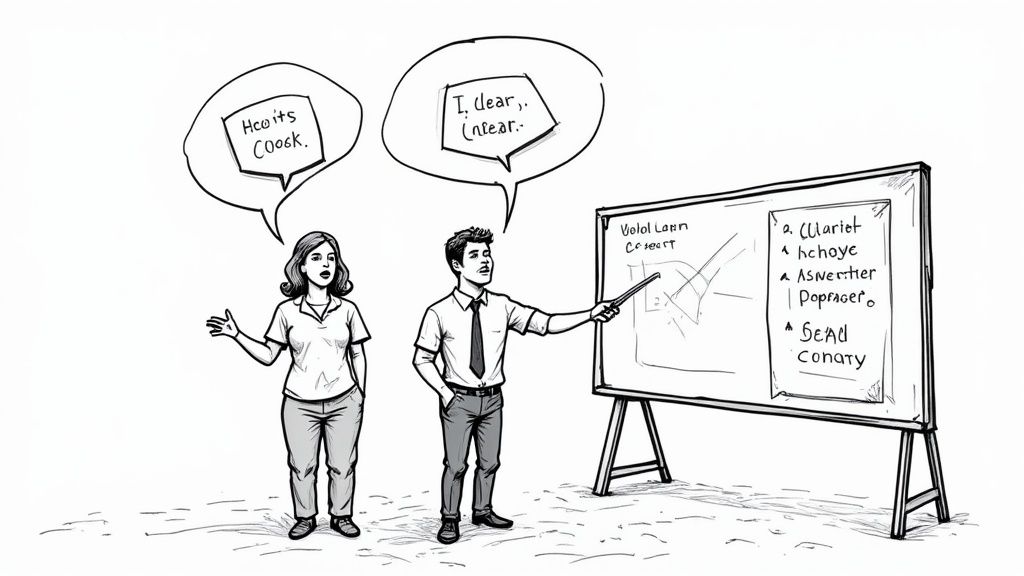Effective Communication Skills Training for Success


"The Real Impact of Communication Training" section:
The Real Impact of Communication Training
Communication skills training delivers real business value and measurable results. When organizations invest in developing these capabilities, they see improvements across individual performance, team collaboration, and financial outcomes.
The Tangible Costs of Poor Communication
Weak communication creates a domino effect of challenges in organizations. Projects get delayed when instructions are unclear. Teams make more mistakes. Employee morale drops and conflicts increase.
Consider a typical scenario: A project team receives vague directions, leading members to work on conflicting priorities. The outcome? Time and effort are wasted as team members duplicate work or head in different directions. Clear communication through targeted training helps prevent these common issues.
The financial impact is significant. Research shows poor communication skills cost the UK economy £22.2 billion each year. A study of over 2,000 UK workers found that 51% missed key opportunities to build essential soft skills. Review the complete UK soft skills research.
The ROI of Effective Communication Training
Well-designed communication training produces clear benefits. Teams make decisions faster, collaborate better, and develop more creative solutions. These improvements link directly to better business results.
Organizations that prioritize communication skills see stronger teamwork, improved client relationships, and increased profits. By helping employees communicate clearly and persuasively, companies enable them to contribute more effectively to key goals.
Measuring Communication Effectiveness
Tracking specific metrics helps organizations assess the impact of their communication training. While feedback is valuable, data provides concrete evidence of progress and ROI.
Here are key metrics showing how communication training affects business outcomes:
| Metric | Average Impact | Industry Benchmark |
|---|---|---|
| Project Completion Rates | +15% | 90% |
| Customer Satisfaction Scores | +10% | 4.5/5 |
| Employee Turnover Rate | -5% | 15% |
| Internal Communication Efficiency | +20% | 80% |
| Conflict Resolution Time | -15% | 2 days |
Regular tracking of these indicators demonstrates the value of investing in communication skills. The data helps organizations prove ROI and make smart decisions about future training programs. Effective communication isn't just about better conversations - it delivers measurable improvements.
Building Your Communication Excellence Framework

Great communication skills require more than just speaking and writing well. You need a complete framework that brings together essential elements to achieve real results. This matters because skill development remains a priority - over 1.2 million adults in the UK participated in further education and training in 2023/24 according to UK education statistics.
Mastering the Core Competencies
Just like a solid foundation supports a house, key communication skills work together to create lasting impact. The essential building blocks include:
- Active Listening: Focus fully on understanding others rather than just waiting to speak. Pay attention to the complete message being shared.
- Non-Verbal Communication: Read and use body language, facial expressions, and tone effectively. These silent signals often say more than words.
- Clear Messaging: Craft focused messages that connect with your audience. Consider who you're speaking to and what you want to achieve.
Consider a team leader running a project meeting. By listening carefully, noting body language, and sharing updates clearly, they create an environment where people feel heard and informed. This blend of skills leads to better outcomes.
Maintaining Authenticity in Communication
While mastering key skills matters, staying true to yourself is just as important. When you communicate authentically, people trust you more and engage with your message. Match your words and actions to build credibility.
Being authentic doesn't mean being rigid - you can adapt while staying genuine. The key is finding your natural communication style while remaining flexible.
Adapting Your Communication Style
Different settings need different approaches. Here's how to adjust effectively:
- High-Stakes Presentations: Plan carefully, speak clearly, and use confident body language to engage large groups
- Important Conversations: Show empathy, listen actively, and express yourself honestly to build stronger connections
Skilled communicators know how to shift their style while staying authentic. This flexibility helps them succeed across various situations.
Assessment and Progress Tracking
Track your growth with practical tools that show where you excel and where to improve:
| Tool | Description |
|---|---|
| Self-Evaluation Questionnaires | Pinpoint specific skills to develop |
| 360-Degree Feedback | Get input from people you work with |
| Practice Exercises | Test your skills in realistic scenarios |
Keep measuring your progress through:
- Daily Notes: Write down what worked and what didn't in your communications
- Peer Input: Ask colleagues for specific feedback on how you communicate
- Results: Look at how communication affects your work outcomes
Using these tools helps you keep growing as a communicator. Remember that building these skills takes time and regular practice. Focus on steady improvement rather than instant perfection.
Industry-Specific Communication Mastery
Every industry requires targeted communication training focused on their unique needs and challenges. A standardized approach won't deliver optimal results. Understanding your sector's specific communication requirements is essential for building effective training programs.
Healthcare: Communicating with Clarity and Compassion
In healthcare settings, clear and empathetic communication can literally save lives. Poor communication can impact patient safety and care quality. Healthcare professionals need specialized training in active listening, delivering difficult news with sensitivity, and explaining complex medical concepts in understandable terms. Training often includes simulated patient consultations to practice both verbal and non-verbal skills. A study of 26 UK medical schools found growing recognition of this need, though training approaches varied widely. Read more about healthcare communication training in this research paper.
Technology: Bridging the Gap Between Technical and Non-Technical
Tech professionals face unique challenges in communicating complex information to diverse audiences. Training focuses on translating technical concepts into clear, accessible language and building strong presentation skills. This helps tech teams effectively communicate with both technical peers and non-technical stakeholders during product launches, investor meetings, and cross-team collaboration. For instance, when a developer needs to explain new features to marketing teams, these communication skills become essential.
Finance: Building Trust and Transparency
Financial professionals must master clear communication about complex topics while building trust. Training emphasizes explaining financial concepts simply, developing client rapport, and handling sensitive money discussions professionally. Programs often include practice scenarios focused on ethical communication and client interactions, given the sensitive nature of financial information and advice.
Education: Fostering Engaging and Inclusive Communication
Teachers require specific skills to create engaging learning environments for all students. Training covers classroom management techniques, communicating across diverse backgrounds, and providing constructive feedback. It also addresses building positive relationships with parents and fellow educators. Creative approaches like storytelling help teachers explain complex topics in ways that capture student interest and improve understanding.
Adapting Traditional Training for Modern Needs
While core communication principles remain important, leading organizations are updating their training methods. New approaches include virtual reality practice scenarios, game-based learning activities, and data-driven personalized training paths. These modern techniques create more engaging and effective learning experiences tailored to each industry's specific needs and challenges.
Closing The Skills Gap That Really Matters

A serious gap exists between communication skills taught in schools and what modern workplaces actually need. This mismatch affects both individual careers and company performance. Finding ways to bridge this divide is essential for helping people develop the real-world communication abilities they need to succeed.
The Disconnect Between Academia and the Workplace
While schools often focus on theory and formal writing, businesses need practical skills like negotiation and persuasion. Many graduates enter the workforce unprepared for everyday workplace communication challenges. A 2016 LinkedIn survey highlighted this problem - communication was rated as the most important soft skill, yet UK universities were not adequately teaching it.
Bridging the Gap with Effective Communication Skills Training
Smart companies are taking action by creating training programs focused on real-world application. These programs give people chances to practice key skills through realistic scenarios. This hands-on training builds confidence in essential areas like active listening, body language, and delivering impactful presentations.
Frameworks for Workplace-Ready Communication
Successful communication training programs use frameworks aligned with business needs. Key components include:
- Needs Assessment: Finding specific communication gaps in the organization
- Targeted Skill Development: Building negotiation, conflict resolution and persuasion abilities
- Practical Application: Using role-playing and real case studies
- Feedback and Coaching: Providing personal guidance to improve skills
- Continuous Improvement: Regular program updates based on results
Practical Strategies for Developing Workplace-Ready Abilities
Results-focused training empowers people to handle complex communication challenges effectively. For example, sales teams can practice pitching and addressing customer concerns through simulated calls - practice opportunities often missing from traditional education.
This practical approach equips people with skills for difficult conversations, relationship building, and team collaboration. The end result is a more productive and positive work environment.
Comparing Academic and Workplace Needs
| Skill Area | Academic Focus | Workplace Needs |
|---|---|---|
| Writing | Formal essays, research papers | Emails, presentations, reports |
| Speaking | Formal presentations, debates | Client interactions, team meetings, negotiations |
| Listening | Lectures, discussions | Active listening in meetings and client interactions |
| Feedback | Receiving grades, peer review | Giving and receiving constructive feedback in a professional setting |
By recognizing these differences between academic and workplace communication needs, organizations can create training that truly prepares people for their careers. Effective communication training leads to better team performance, stronger client relationships, and improved business results.
Mastering Data-Driven Communication

While businesses collect huge amounts of data, numbers alone don't drive decisions. The real value comes from turning complex data into clear and compelling stories that motivate action. This requires mastering data-driven communication - combining strong data analysis with clear storytelling to create impactful business narratives.
The Power of Data Storytelling
Great data storytelling goes beyond presenting statistics. It creates a meaningful narrative that provides context, highlights key patterns, and draws out valuable insights. Think of raw data as ingredients that need a recipe (the story) to become a delicious meal that others want to consume.
For instance, rather than just showing a sales decline graph, an effective communicator explains what caused the drop - perhaps new market competition or shifting customer preferences. This context helps others understand what the numbers really mean for the business.
Developing Data Storytelling Abilities
Strong data stories start with knowing your audience - their interests, data comfort level, and background knowledge. This helps you frame information in ways that connect with them.
Build your story logically: Define the key issue or opportunity, support it with relevant data visualizations, and end with clear next steps. Good visuals like charts make complex information easier to grasp. The goal is driving informed decisions through a combination of clear narrative and compelling evidence.
Presenting Technical Information Effectively
Making technical data accessible to non-technical audiences requires careful translation. Using everyday analogies helps - for example, comparing a complex algorithm to a sorting machine makes the concept more relatable.
Visual elements like graphs and infographics can transform dense data into clear insights. Use simple, direct language and avoid unnecessary jargon. A UK study found that 23% of companies said data-focused graduates needed better communication skills, even with 178,000 to 234,000 data roles available. Read the full UK data skills report here.
Maintaining Accuracy and Credibility
While engaging storytelling matters, accuracy and credibility are essential. Always verify your data sources, explain your methods clearly, and acknowledge any limitations upfront.
Let the data guide your narrative rather than forcing it to fit a predetermined story. Being transparent about your process builds trust and ensures your insights drive real business value. When done well, data-driven communication helps organizations make smarter, more informed decisions.
Measuring Real Communication Impact

Delivering communication skills training is just the first step. Organizations need clear evidence that their programs create meaningful change. This means looking beyond standard feedback forms to examine how training drives real business improvements. Let's explore effective ways to measure impact, track progress, and prove the value of communication training investments.
Evaluating Program Effectiveness
To get a complete picture of training impact, organizations need to examine multiple areas:
- Team Dynamics: Look for improvements in collaboration and faster conflict resolution
- Individual Growth: Measure gains in communication confidence and reduced mistakes
- Business Results: Track project completion speed and customer satisfaction levels
For example, when teams communicate better, projects move faster - showing a direct link between training and bottom-line results. Examining these different levels helps paint a clear picture of program success.
Tracking Progress and Demonstrating ROI
Numbers tell the story when it comes to proving training value. Set specific metrics upfront and monitor them consistently:
- Project Timeline Changes: Compare completion speeds before and after training
- Client Relationships: Look at retention rates and satisfaction scores
- Sales Performance: Check if better communication leads to more closed deals
These concrete metrics help prove the business case for training investment. When you can show real improvements in key areas, it's easier to justify continued program funding.
Gathering Meaningful Feedback and Continuous Improvement
Ongoing feedback from multiple sources helps programs stay effective:
- Post-Training Surveys: Get direct input on content quality and practical value
- Peer and Manager Input: Collect 360-degree feedback on communication skill growth
- Real-World Observation: Watch how people apply new skills in actual work situations
Use this input to keep improving. If participants want more presentation practice, adjust the program. Regular reviews and updates ensure training stays relevant and impactful.
Ready-to-Use Assessment Tools and Benchmark Standards
Standard assessment tools provide key advantages:
- Clear Measurements: Get consistent, objective skill evaluations
- Industry Comparison: See how your results stack up against similar organizations
- Focused Development: Identify specific areas needing more attention
With this systematic approach to measurement, organizations can maximize their communication training results. The data shows what's working, what needs adjustment, and how training drives business success.
Ready to elevate your coaching practice and empower your clients to communicate more effectively? Visit Coaching Hub for valuable resources and insights.